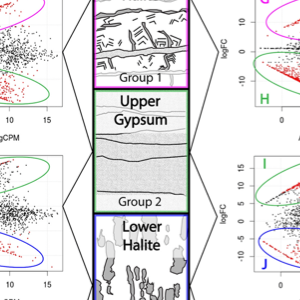Link to online paper: https://doi.org/10.1128/mSphere.00378-19
Abstract
We report the first census of natural microbial communities of the Bonneville Salt Flats (BSF), a perennial salt pan at the Utah-Nevada border. Environmental DNA sequencing of archaeal and bacterial 16S rRNA genes was conducted on samples from multiple evaporite sediment layers collected from the upper 30 cm of the surface salt crust. Our results show that at the time of sampling (September 2016), BSF hosted a robust microbial community dominated by diverse halobacteria and Salinibacter species. Sequences identical to Geitlerinema sp. strain PCC 9228, an anoxygenic cyanobacterium that uses sulfide as the electron donor for photosynthesis, are also abundant in many samples. We identified taxonomic groups enriched in each layer of the salt crust sediment and revealed that the upper gypsum sediment layer found immediately under the uppermost surface halite contains a robust microbial community. In these sediments, we found an increased presence of Thermoplasmatales, Hadesarchaeota, Nanoarchaeaeota, Acetothermia, Desulfovermiculus, Halanaerobiales, Bacteroidetes, and Rhodovibrio. This study provides insight into the diversity, spatial heterogeneity, and geologic context of a surprisingly complex microbial ecosystem within this macroscopically sterile landscape.
